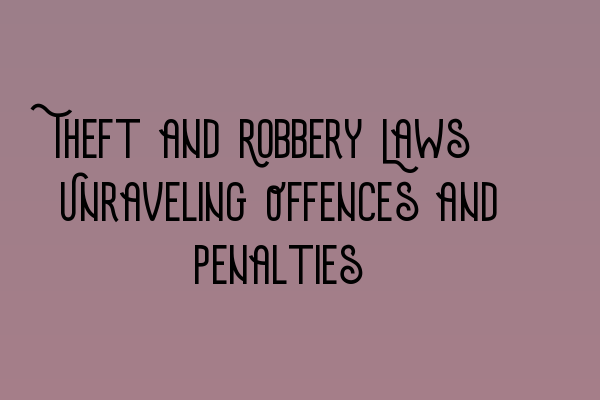Theft and Robbery Laws: Unraveling Offences and Penalties
Welcome to the SQE Criminal Law & Practice Law UK blog! In this post, we will delve into the intricate details of theft and robbery laws, exploring the various offences and the corresponding penalties. Understanding these laws is essential for any aspiring solicitor, and it forms a fundamental part of the SQE 1 and SQE 2 examinations.
Before we proceed, if you are looking to test your knowledge and prepare for the SQE 1 exam, our SQE 1 Practice Exam Questions and SQE 1 Practice Mocks FLK1 FLK2 articles can provide valuable practice material. Additionally, if you are interested in our comprehensive SQE 1 and SQE 2 preparation courses, please visit our SQE 1 Preparation Courses and SQE 2 Preparation Courses pages.
Theft
Theft is a common criminal offence that involves the unlawfully taking or using of another person’s property with the intent to permanently deprive them of it. The offence of theft is outlined under Section 1 of the Theft Act 1968. It encompasses a wide range of acts, from shoplifting to embezzlement.
One of the key elements of theft is the dishonest intent to permanently deprive the owner of the property. This intent can be proven through various means, such as the use of force, trespassing, or deception. If convicted of theft, the penalties can vary depending on the value of the stolen property and other aggravating factors. It is crucial to consult a qualified solicitor to understand the exact implications of each case.
Robbery
While theft involves the act of taking someone’s property, robbery takes it a step further by involving the use of force or the threat of force. It is a more serious offence and carries stricter penalties. Robbery is covered under Section 8 of the Theft Act 1968.
In a robbery, the individual not only intends to permanently deprive the victim of their property but also uses force, or the threat of force, to make the victim surrender their belongings. The use of force can range from physical violence to the brandishing of a weapon. The severity of the penalties for robbery depends on various factors, including the level of violence employed and the value of the stolen items.
It is worth noting that there are different degrees of robbery, such as armed robbery, aggravated robbery, and street robbery. Each has its own set of specific elements and corresponding penalties. For example, armed robbery involves the use of a weapon, leading to enhanced penalties if convicted.
Punishments and Defense Strategies
The penalties for theft and robbery offences can be severe, including imprisonment, fines, and even community service. It is crucial for solicitors to have a deep understanding of the laws surrounding these offences to provide effective legal representation to their clients.
When defending clients charged with theft or robbery, multiple defense strategies can be employed. These strategies depend on the specific circumstances of each case and may include challenging the intent to permanently deprive, disputing the use of force, or presenting evidence of an alibi. A skilled solicitor will carefully analyze the case and develop the most appropriate defense strategy for their client.
In conclusion, theft and robbery laws are complex and involve a nuanced understanding of the Theft Act 1968. Aspiring solicitors should thoroughly familiarize themselves with these laws and the corresponding penalties. If you are preparing for the SQE 1 or SQE 2 exams, make sure to explore our SQE 1 Preparation Courses and SQE 2 Preparation Courses. Stay focused, stay informed, and embrace the journey towards becoming an exceptional solicitor!
For more information on important dates and deadlines for the SRA SQE exams, please visit our SRA SQE Exam Dates article.
